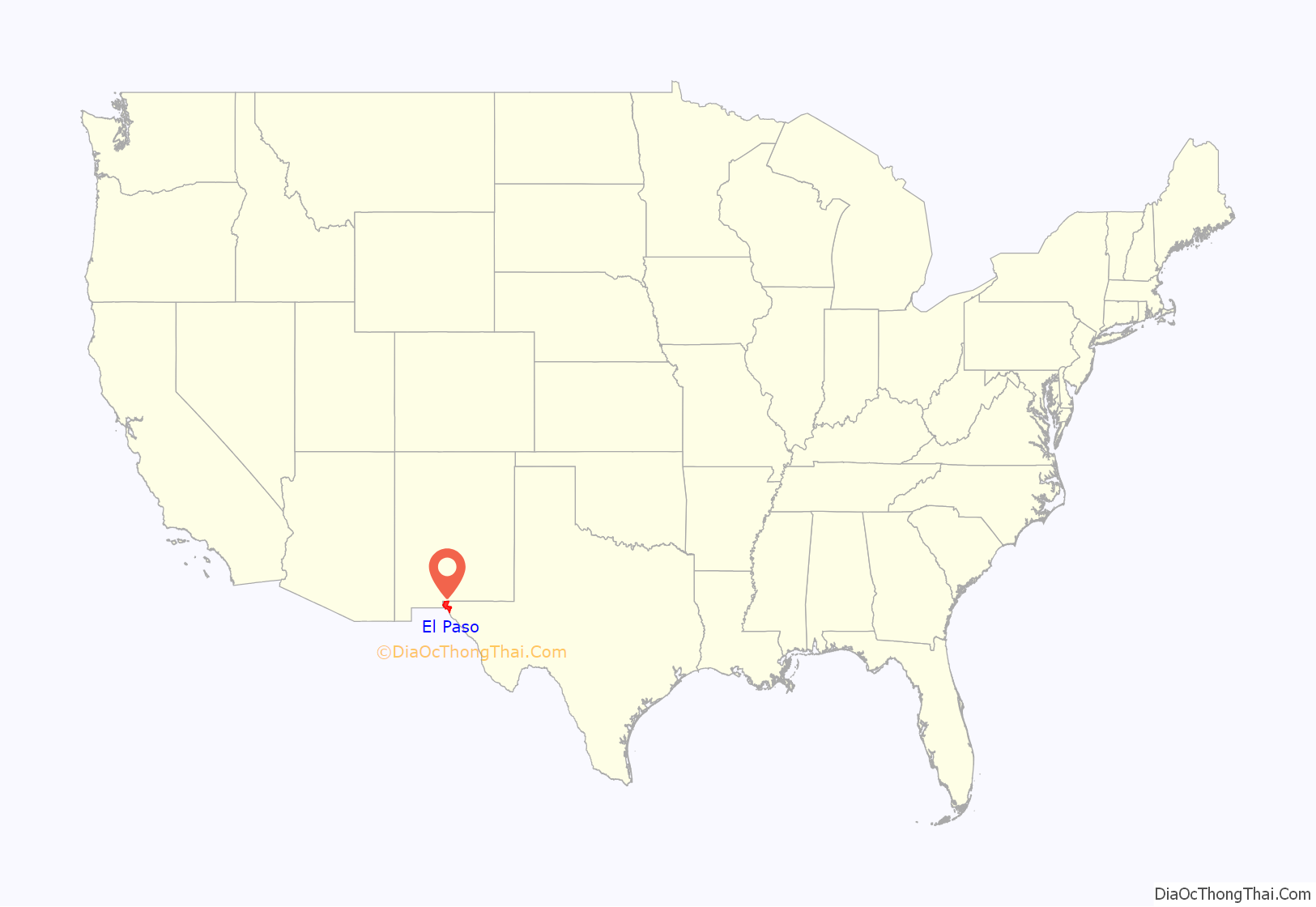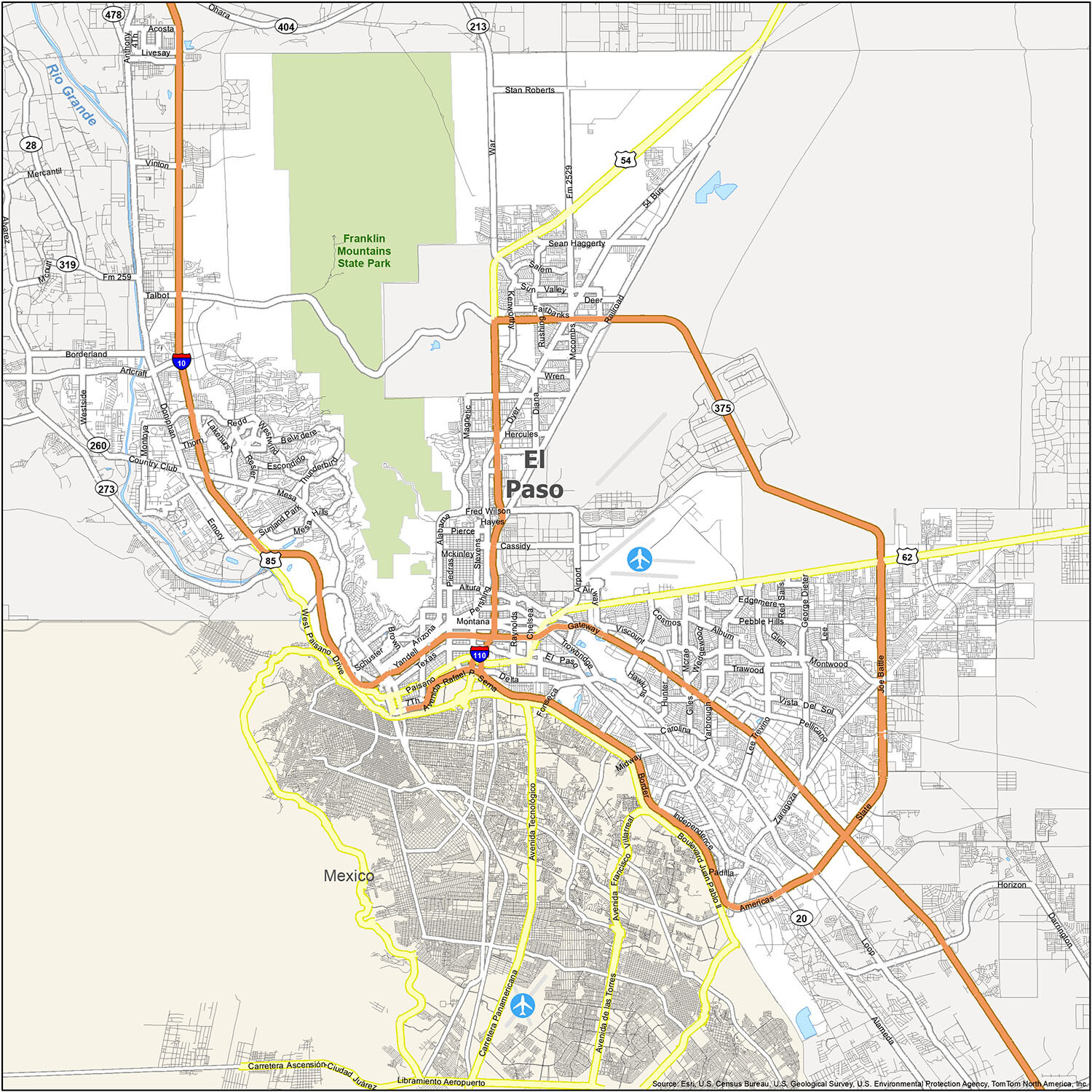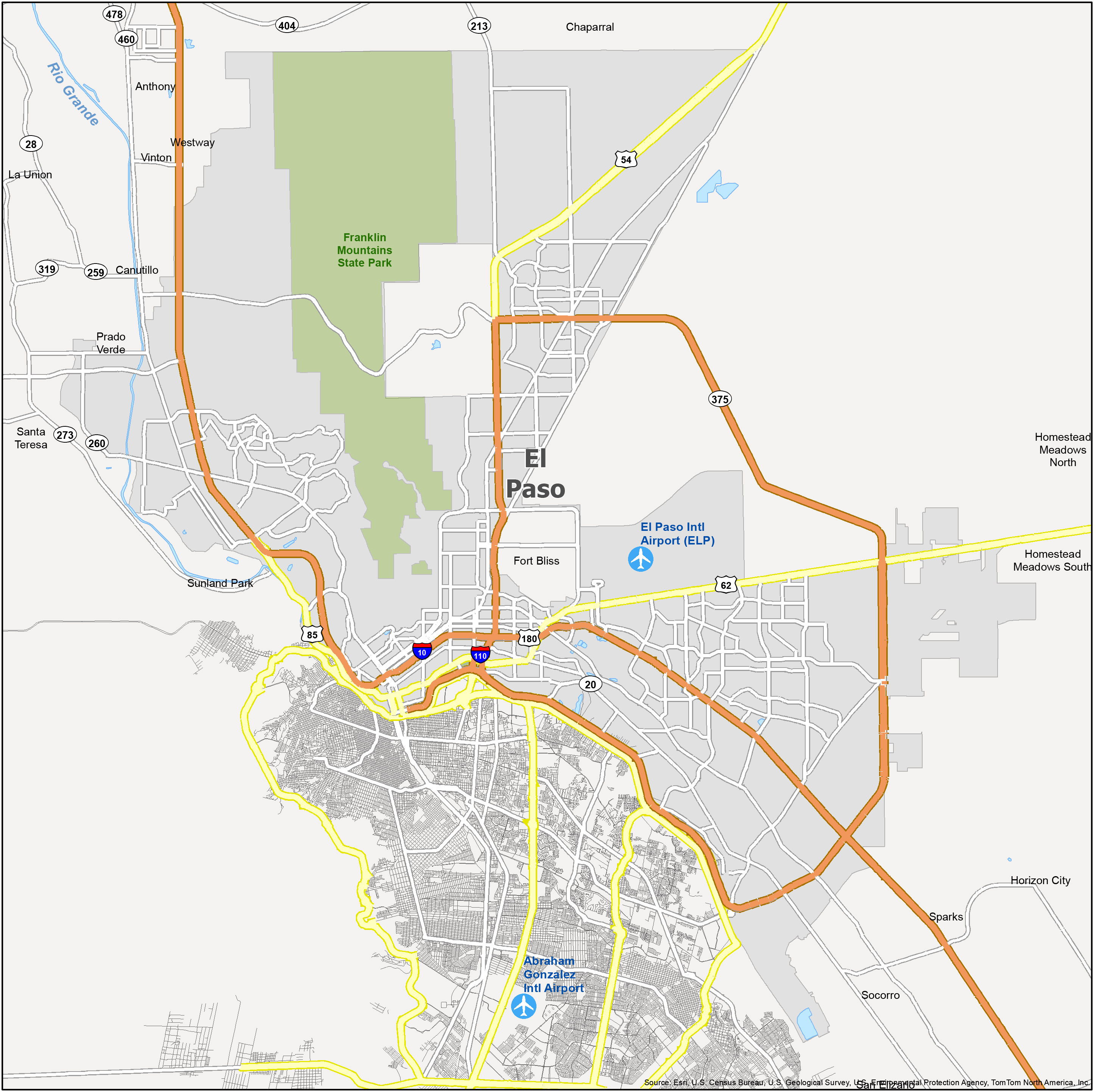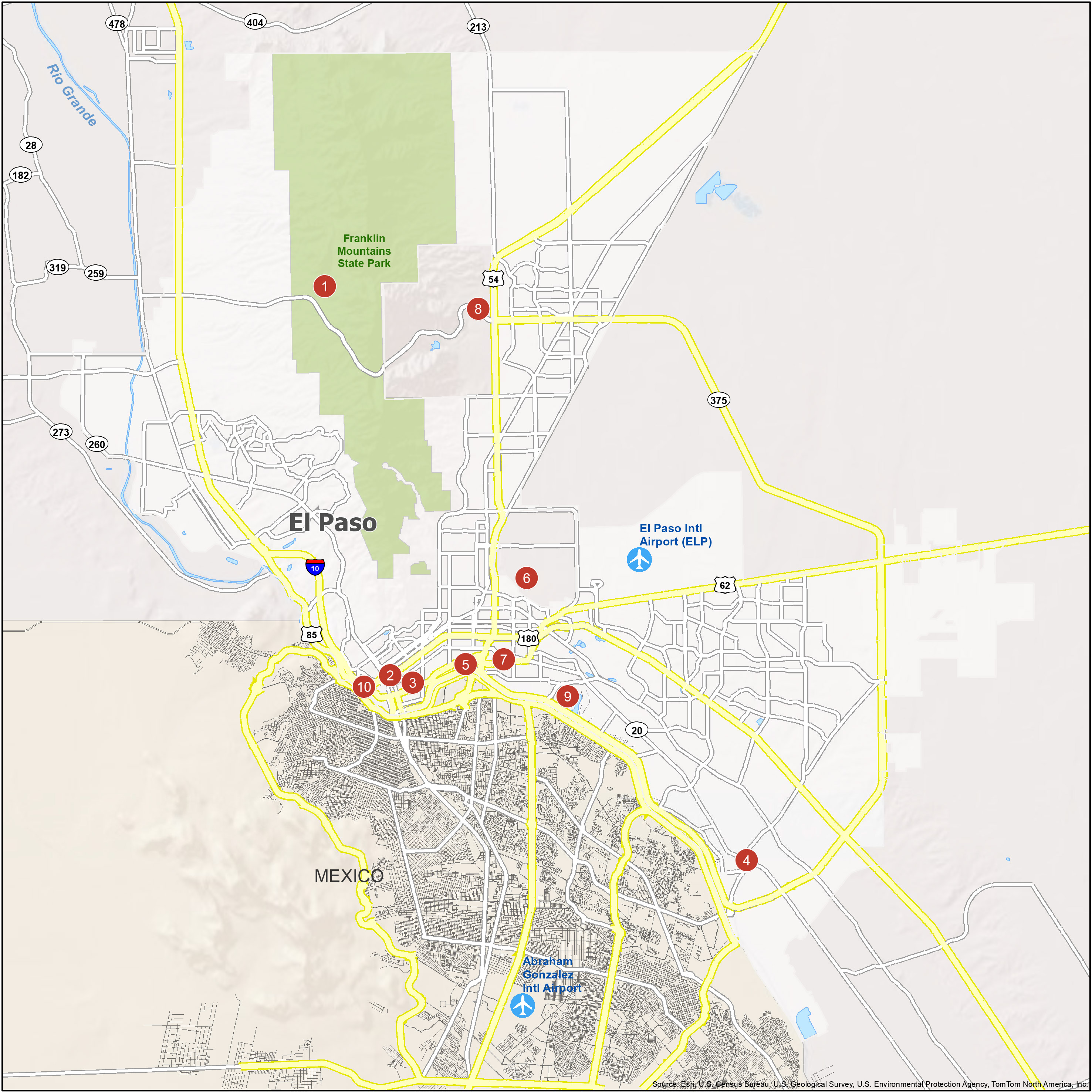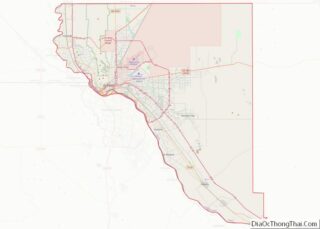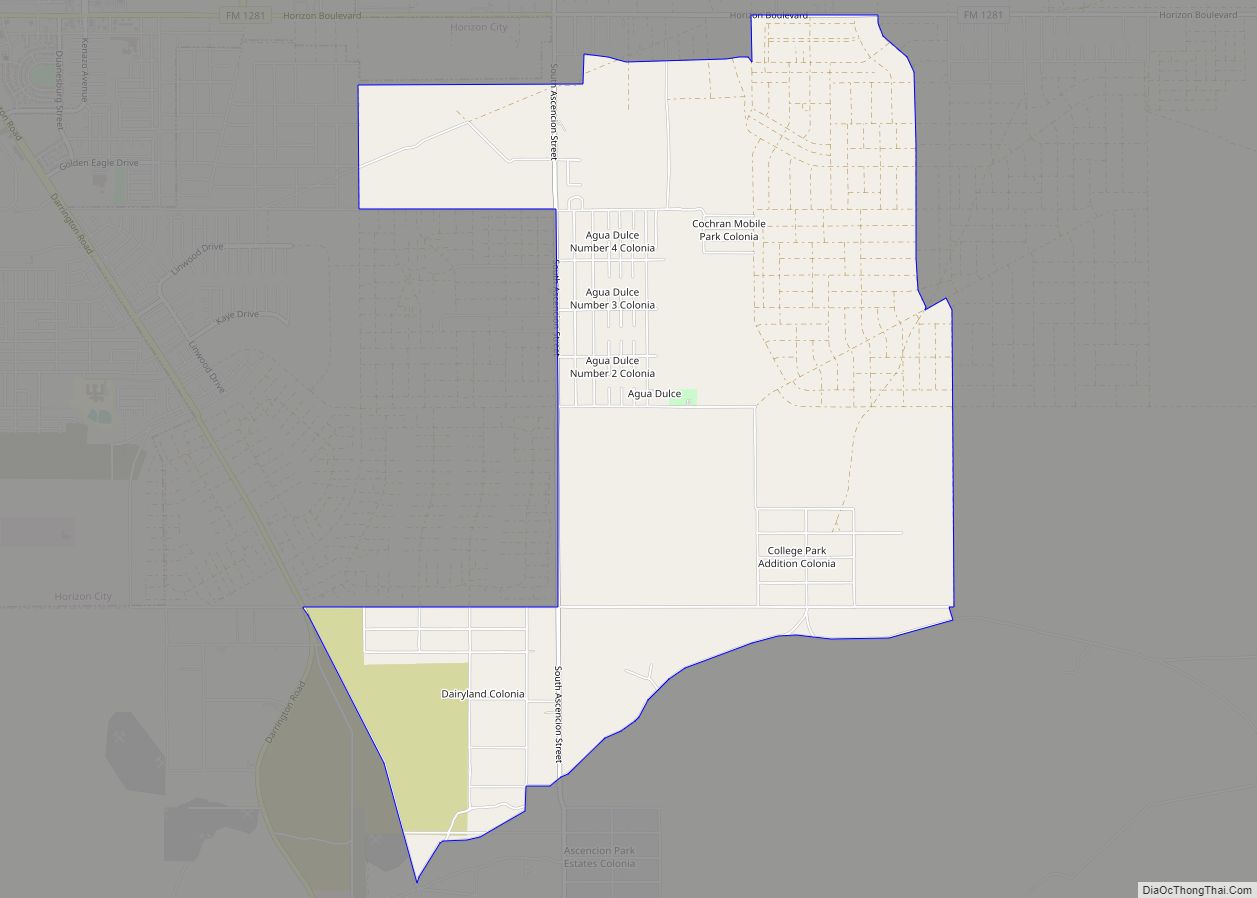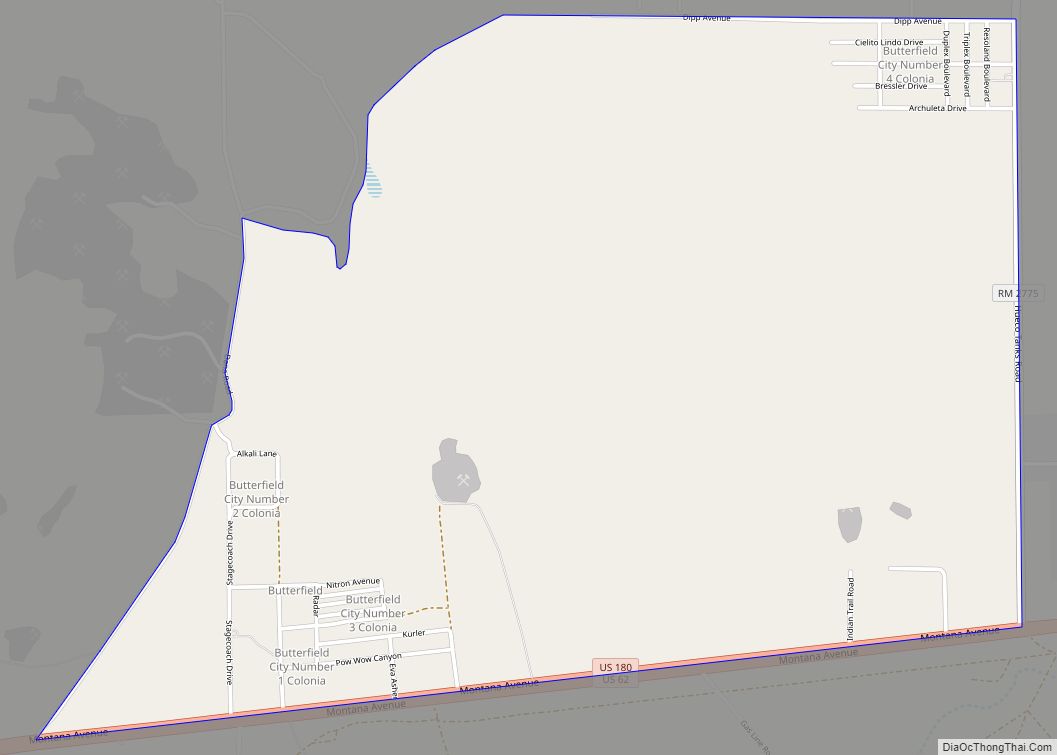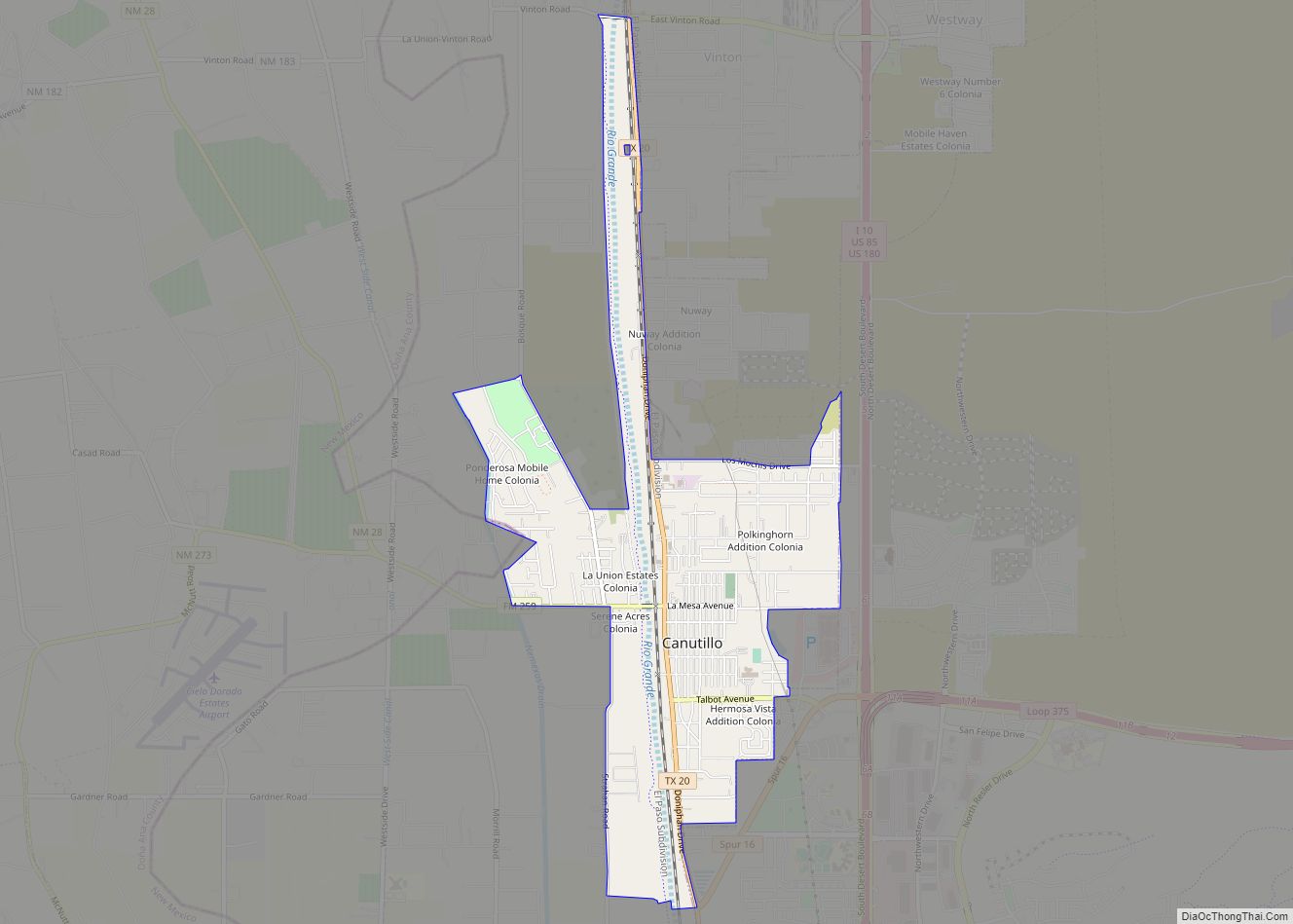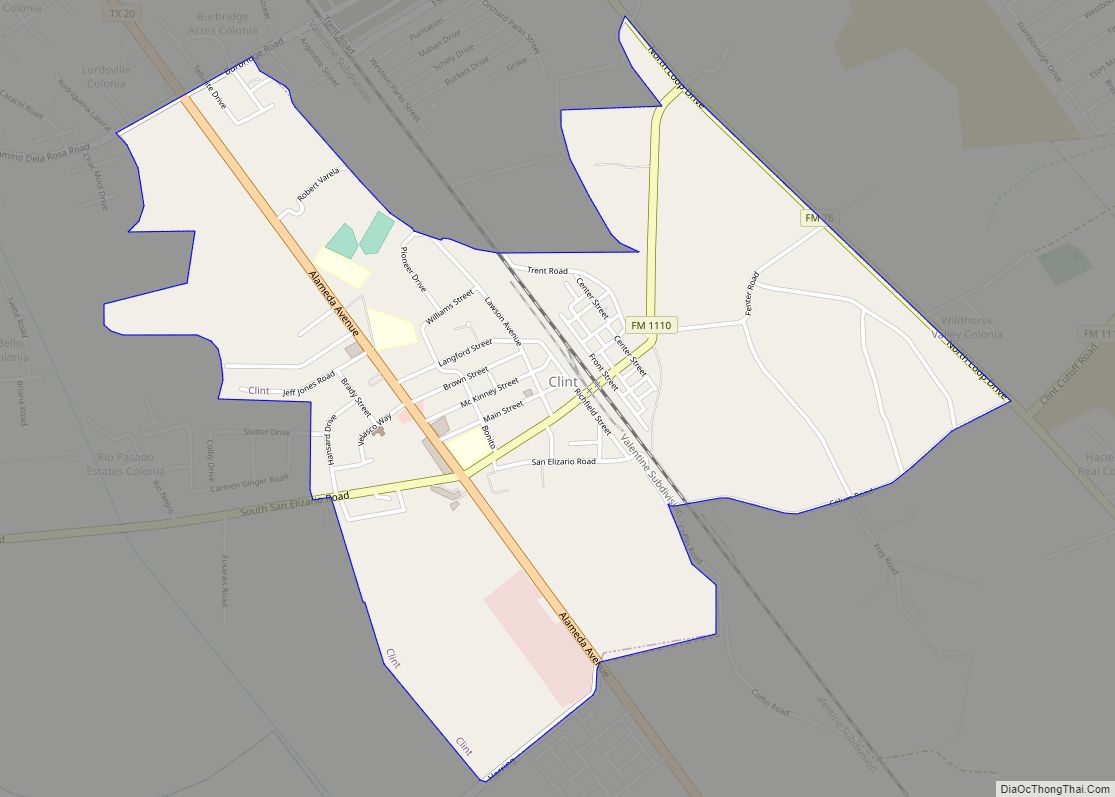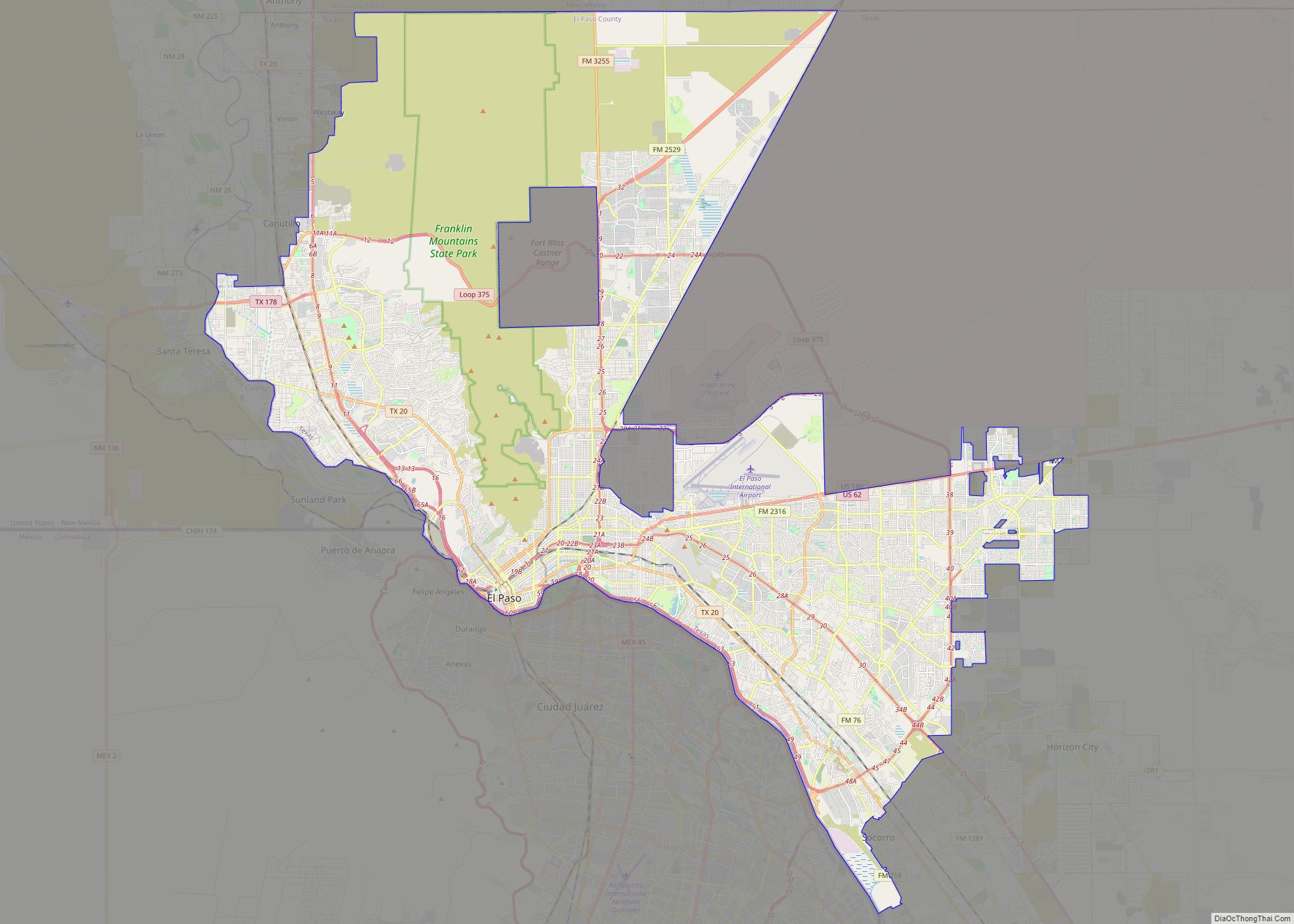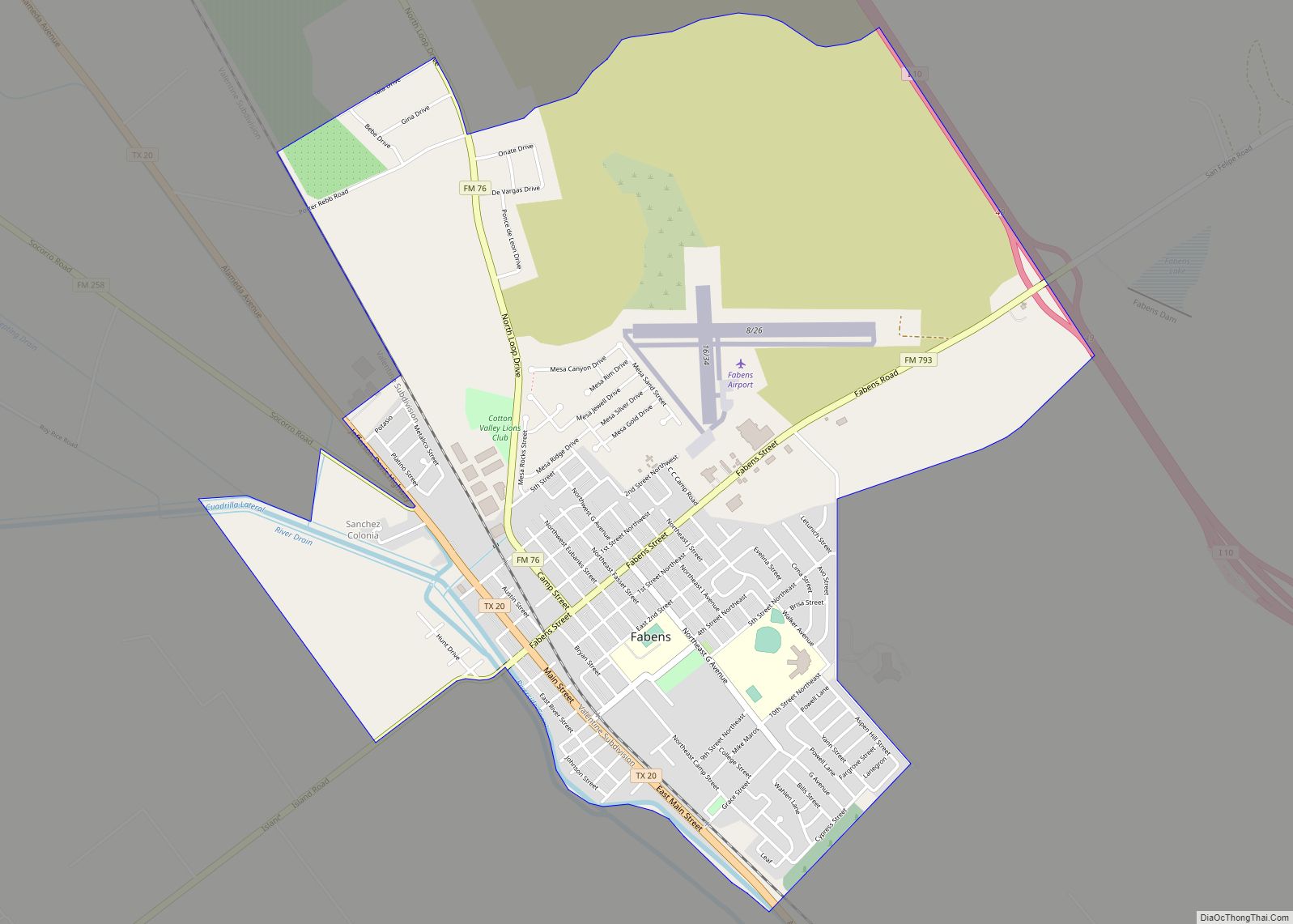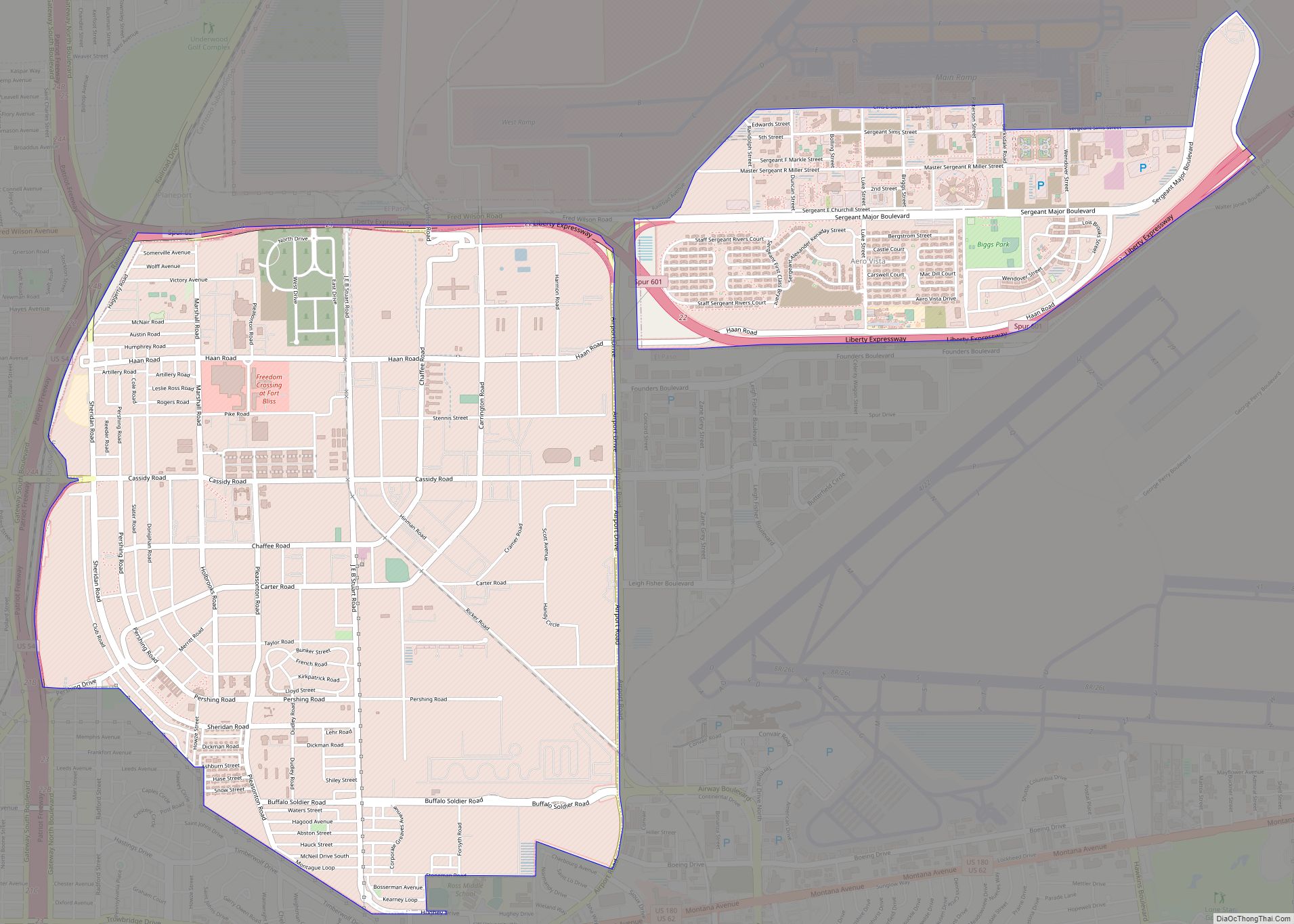El Paso (/ɛl ˈpæsoʊ/; Spanish: [el ˈpaso]; lit. ’the pass’ or ‘the step’) is a city in and the county seat of El Paso County, Texas, United States. The 2020 population of the city from the U.S. Census Bureau was 678,815, making it the 22nd-largest city in the U.S., the sixth-largest city in Texas. The city has also the largest hispanic population share of main cities in the U.S. with 81% of its population being Hispanic. Its metropolitan statistical area covers all of El Paso and Hudspeth counties in Texas, and had a population of 868,859 in 2020. El Paso has consistently been ranked as one of the safest large cities in the United States.
El Paso stands on the Rio Grande across the Mexico–United States border from Ciudad Juárez, the most populous city in the Mexican state of Chihuahua with over 1.5 million people. The Las Cruces area, in the neighboring U.S. state of New Mexico, has a population of 219,561. On the U.S. side, the El Paso metropolitan area forms part of the larger El Paso–Las Cruces combined statistical area, with a population of 1,092,742.
These three cities form a combined international metropolitan area sometimes referred to as the Paso del Norte or the Borderplex. The region of 2.7 million people constitutes the largest bilingual and binational workforce in the Western Hemisphere.
The city is home to three publicly traded companies, and former Western Refining, now Marathon Petroleum, as well as home to the Medical Center of the Americas, the only medical research and care provider complex in West Texas and Southern New Mexico, and the University of Texas at El Paso, the city’s primary university. The city hosts the annual Sun Bowl college football postseason game, the second-oldest bowl game in the country.
El Paso has a strong federal and military presence. William Beaumont Army Medical Center, Biggs Army Airfield, and Fort Bliss are located in the area. Fort Bliss is one of the largest military complexes of the United States Army and the second-largest training area in the U.S. behind nearby White Sands Missile Range. The fort is headquartered in El Paso but a large part of the training area is in New Mexico. Also headquartered in El Paso is the Drug Enforcement Administration domestic field division 7, El Paso Intelligence Center, Joint Task Force North, United States Border Patrol El Paso Sector, and U.S. Border Patrol Special Operations Group.
El Paso is a five-time All-America City Award winner, winning in 1969, 2010, 2018, 2020, and 2021, and Congressional Quarterly ranked it in the top-three safest large cities in the United States between 1997 and 2014, including holding the title of the safest city between 2011 and 2014.
| Name: | El Paso city |
|---|---|
| LSAD Code: | 25 |
| LSAD Description: | city (suffix) |
| State: | Texas |
| County: | El Paso County |
| Incorporated: | 1873 |
| Elevation: | 3,740 ft (1,140 m) |
| Land Area: | 258.43 sq mi (669.33 km²) |
| Water Area: | 0.82 sq mi (2.13 km²) |
| Population Density: | 2,626.69/sq mi (1,014.17/km²) |
| FIPS code: | 4824000 |
| GNISfeature ID: | 1380946 |
| Website: | www.elpasotexas.gov |
Discover the sights, sounds, and attractions of the Sun City with this interactive El Paso map.
Explore the city of El Paso with this interactive map. Discover roads, reference points, and a list of things to do in the Boot Capital of the World and Sun City. Find family-friendly activities and kid-friendly attractions to make your visit to El Paso unforgettable.
Online Interactive Map
Click on ![]() to view map in "full screen" mode.
to view map in "full screen" mode.
The El Paso map is an interactive tool that gives you a bird’s eye view of the city. You can zoom in and out at any point and get a really good look at the neighborhoods. This map includes all of the top attractions as well as a detailed street-level view of the city. With a fast and easy interface, you can pinpoint your location and get to it quickly.
El Paso location map. Where is El Paso city?
History
Early years
The El Paso region has had human settlement for thousands of years, as evidenced by Folsom points from hunter-gatherers found at Hueco Tanks. This suggests 10,000 to 12,000 years of human habitation. The earliest known cultures in the region were maize farmers. When the Spanish arrived, the Manso, Suma, and Jumano tribes populated the area. These were subsequently incorporated into the mestizo culture, along with immigrants from central Mexico, captives from Comanchería, and genízaros of various ethnic groups. The Mescalero Apache were also present.
The Chamuscado and Rodríguez Expedition trekked through present-day El Paso and forded the Rio Grande where they visited the land that is present-day New Mexico in 1581–1582. The expedition was led by Francisco Sánchez, called “El Chamuscado”, and Fray Agustín Rodríguez, the first Spaniards known to have walked along the Rio Grande and visited the Pueblo Indians since Francisco Vásquez de Coronado 40 years earlier. Spanish explorer Don Juan de Oñate was born in 1550 in Zacatecas, Zacatecas, Mexico, and was the first New Spain (Mexico) explorer known to have rested and stayed 10 days by the Rio Grande near El Paso, in 1598, celebrating a Thanksgiving Mass there on April 30, 1598. Four survivors of the Narváez expedition, Álvar Núñez Cabeza de Vaca, Alonso del Castillo Maldonado, Andrés Dorantes de Carranza, and a Moor that was enslaved Estevanico, are thought to have crossed the Rio Grande into present-day Mexico about 75 miles south of El Paso in 1535. El Paso del Norte (present-day Ciudad Juárez) was founded on the south bank of the Río Bravo del Norte (Rio Grande), in 1659 by Fray Garcia de San Francisco. In 1680, the small village of El Paso became the temporary base for Spanish governance of the territory of New Mexico as a result of the Pueblo Revolt, until 1692, when Santa Fe was reconquered and once again became the capital.
The Texas Revolution (1836) was generally not felt in the region, as the American population was small, not more than 10% of the population. However, the region was claimed by Texas as part of the treaty signed with Mexico and numerous attempts were made by Texas to bolster these claims, but the villages that consisted of what is now El Paso and the surrounding area remained essentially a self-governed community with both representatives of the Mexican and Texan governments negotiating for control until Texas irrevocably took control in 1846. During this interregnum, 1836–1848, Americans nonetheless continued to settle the region. As early as the mid-1840s, alongside long extant Hispanic settlements such as the Rancho de Juan María Ponce de León, Anglo-American settlers such as Simeon Hart and Hugh Stephenson had established thriving communities of American settlers owing allegiance to Texas. Stephenson, who had married into the local Hispanic aristocracy, established the Rancho de San José de la Concordia, which became the nucleus of Anglo-American and Hispanic settlement within the limits of modern-day El Paso, in 1844: the Republic of Texas, which claimed the area, wanted a chunk of the Santa Fe trade. During the Mexican–American War, the Battle of El Bracito was fought nearby on Christmas Day, 1846. The Treaty of Guadalupe Hidalgo effectively made the settlements on the north bank of the river part of the US, separate from Old El Paso del Norte on the Mexican side. The present New Mexico–Texas boundary placing El Paso on the Texas side was drawn in the Compromise of 1850.
El Paso remained the largest settlement in New Mexico as part of the Republic of Mexico until its cession to the U.S. in 1848, when the Treaty of Guadalupe Hidalgo specified the border was to run north of El Paso De Norte around the Ciudad Juárez Cathedral which became part of the state of Chihuahua.
El Paso County was established in March 1850, with San Elizario as the first county seat. The United States Senate fixed a boundary between Texas and New Mexico at the 32nd parallel, thus largely ignoring history and topography. A military post called the “Post opposite El Paso” (meaning opposite El Paso del Norte, across the Rio Grande) was established in 1849 on Coons’ Rancho beside the settlement of Franklin, which became the nucleus of the future El Paso, Texas; after the army left in 1851, the rancho went into default and was repossessed; in 1852, a post office was established on the rancho bearing the name El Paso as an example of cross-border town naming until El Paso del Norte was renamed Juarez in 1888. After changing hands twice more, the El Paso company was set up in 1859 and bought the property, hiring Anson Mills to survey and lay out the town, thus forming the current street plan of downtown El Paso.
In Beyond the Mississippi (1867), Albert D. Richardson, traveling to California via coach, described El Paso as he found it in late 1859:
During the Civil War, Confederate military forces were in the area until it was captured by the Union California Column in August 1862. It was then headquarters for the 5th Regiment California Volunteer Infantry from August 1863 until December 1864.
After the Civil War’s conclusion, the town’s population began to grow as Texans continued to move into the villages and soon became the majority. El Paso itself, incorporated in 1873, encompassed the small area of communities that had developed along the river. In the 1870s, a population of 23 non-Hispanic Whites and 150 Hispanics was reported. With the arrival of the Southern Pacific, Texas and Pacific, and Atchison, Topeka and Santa Fe railroads in 1881, the population boomed to 10,000 by the 1890 census, with many Anglo-Americans, recent immigrants, old Hispanic settlers, and recent arrivals from Mexico. The location of El Paso and the arrival of these more wild newcomers caused the city to become a violent and wild boomtown known as the “Six-shooter Capital” because of its lawlessness. Indeed, prostitution and gambling flourished until World War I when the Department of the Army pressured El Paso authorities to crack down on vice (thus “benefitting” vice in neighboring Ciudad Juárez). With the suppression of the vice trade and in consideration of the city’s geographic position, the city continued into developing as a premier manufacturing, transportation, and retail center of the U.S. Southwest.
1900–present
In 1909, William Howard Taft and Porfirio Díaz planned a summit in El Paso, Texas, and Ciudad Juárez, Mexico, a historic first meeting between a U.S. president and a Mexican president and also the first time an American president crossed the border into Mexico, but tensions rose on both sides of the border, including threats of assassination, so the Texas Rangers, 4,000 U.S. and Mexican troops, U.S. Secret Service agents, FBI agents, and U.S. marshals were all called in to provide security. Frederick Russell Burnham, a celebrated scout, was put in charge of a 250-strong private security detail hired by John Hays Hammond, who in addition to owning large investments in Mexico, was a close friend of Taft from Yale and a U.S. vice presidential candidate in 1908. On October 16, the day of the summit, Burnham and Private C.R. Moore, a Texas Ranger, discovered a man
holding a concealed palm pistol standing at the El Paso Chamber of Commerce building along the procession route. Burnham and Moore captured, disarmed, and arrested the assassin within only a few feet of Taft and Díaz. By 1910, an overwhelming number of people in the city were Americans, creating a settled environment, but this period was short-lived as the Mexican Revolution greatly impacted the city, bringing an influx of refugees—and capital—to the bustling boom town. Spanish-language newspapers, theaters, movie houses, and schools were established, many supported by a thriving Mexican refugee middle class. Large numbers of clerics, intellectuals, and businessmen took refuge in the city, particularly between 1913 and 1915. Ultimately, the violence of the Mexican Revolution followed the large Mexican diaspora, who had fled to El Paso. In 1915 and again in 1916 and 1917, various Mexican revolutionary societies planned, staged, and launched violent attacks against both Texans and their political Mexican opponents in El Paso. This state of affairs eventually led to the vast Plan de San Diego, which resulted in the murder of 21 American citizens. The subsequent reprisals by a local militia soon caused an escalation of violence, wherein an estimated 300 Mexicans and Mexican-Americans lost their lives. These actions affected almost every resident of the entire Rio Grande Valley, resulting in millions of dollars of losses; the end result of the Plan of San Diego was long-standing enmity between the two ethnic groups.
Simultaneously, other Texans and Americans gravitated to the city, and by 1920, along with the U.S. Army troops, the population exceeded 100,000, and non-Hispanic Whites once again were in the clear majority. Nonetheless, the city increased the segregation between Mexicans and Mexican-Americans with non-Hispanic Whites. One prominent form of segregation, in the form of immigration controls to prevent disease, allegedly was abused to create nonconsensual pornographic images of women distributed in local bars. These rumors along with the perceived hazard from kerosene baths led to the 1917 Bath riots. As a result of the increased segregation, the Catholic Church attempted to garner the Mexican-American community’s allegiance through education and political and civic involvement organizations, including the National Catholic Welfare Fund. In 1916, the Census Bureau reported El Paso’s population as 53% Mexican and 44% Non-Hispanic whites. Mining and other industries gradually developed in the area. The El Paso and Northeastern Railway was chartered in 1897, to help extract the natural resources of surrounding areas, especially in southeastern New Mexico Territory. The 1920s and 1930s had the emergence of major business development in the city, partially enabled by Prohibition-era bootlegging. The military demobilization, and agricultural economic depression, which hit places like El Paso first before the larger Great Depression was felt in the big cities, though, hit the city hard. In turn, as in the rest of the United States, the Depression era overall hit the city hard, and El Paso’s population declined through the end of World War II, with most of the population losses coming from the non-Hispanic White community. Nonetheless, they remained the majority to the 1940s.
During and following the war, military expansion in the area, as well as oil discoveries in the Permian Basin, helped to engender rapid economic expansion in the mid-1900s. Copper smelting, oil refining, and the proliferation of low-wage industries (particularly garment making) led to the city’s growth. Additionally, the departure of the region’s rural population, which was mostly non-Hispanic White, to cities like El Paso, brought a short-term burst of capital and labor, but this was balanced by additional departures of middle-class Americans to other parts of the country that offered new and better-paying jobs. In turn, local businesses looked south to the opportunities afforded by cheap Mexican labor. Furthermore, the period from 1942 to 1956 had the bracero program, which brought cheap Mexican labor into the rural area to replace the losses of the non-Hispanic White population. In turn, seeking better-paying jobs, these migrants also moved to El Paso. By 1965, Hispanics once again were a majority. Meanwhile, the postwar expansion slowed again in the 1960s, but the city continued to grow with the annexation of surrounding neighborhoods and in large part because of its significant economic relationship with Mexico.
The Farah Strike, 1972–1974, occurred in El Paso, Texas. This strike was originated and led by Chicanas, or Mexican-American women, against the Farah Manufacturing Company, due to complaints against the company inadequately compensating workers. Texas Monthly described the Farah Strike as the “strike of the century”.
On August 3, 2019, a terrorist shooter espousing white supremacy killed 23 people at a Walmart and injured 23 others.
El Paso Road Map
Planning a trip to El Paso? You’ll need a map of the city to get around. El Paso is the fourth-largest city in Texas, located in the northwest part of the state, bordering Mexico. With nearly 700,000 people, it’s an interesting area for a day trip. This map will help you find your way around and will show you the major highways and roads in the city. If you’re traveling outside El Paso, you can also download a Texas road map to help you get around the Lone Star state.
Interstate Highways: I-10, I-110
US Highways: 20, 54, 62, 85, 180, 260, 375, Border Hwy, El Paso State Loop, Pete V Domenici Intl Beltway, War Hwy
Major Roads: Alameda Ave, Americas Ave, Artcraft Rd, Borderland Rd, Country Club Rd, Doniphan Dr, Dyer St, El Paso St, Executive Center Blvd, Gateway Blvd, Hercules Ave, Joe Battle Blvd, Kenworthy St, Martin Luther King, Mesa St, Paisano Dr, Montana Ave, Santa Fe St, Stanton St, State Line Rd, Talbot Ave, Texas Ave, Westside Dr, Woodrow Bean Transmountain Dr
Explore the best that El Paso has to offer with a visit to the city and its many attractions. From the El Paso International Airport to the Anthony, El Paso, Horizon City, San Elizario, Socorro, Sunland Park and Canutillo, Chaparral, Fort Bliss, Homestead Meadows North, Homestead Meadows South, La Union, Prado Verde, Santa Teresa, Sparks, Westway cities, there are plenty of places to visit and explore. Whether you’re planning a family vacation or a day trip, our map of El Paso will help you find the best places to visit and explore.
10 things to do in El Paso city
El Paso, Texas is a vibrant city with plenty of things to do. From exploring its historic downtown to attending a cultural event, enjoying a live music show, or visiting one of its many museums and parks, there are plenty of activities to choose from. If you want to experience the best of El Paso, make sure to check out the top 10 attractions we’ve listed above. You won’t regret it!
El Paso, Texas is the perfect destination for travelers looking for a unique experience. From exploring its historic downtown to attending a cultural event, enjoying a live music show, or visiting one of its many museums and parks, there are plenty of activities to keep you busy. If you’re looking for things to do in El Paso, make sure to check out our top 10 travel recommendations. From the Franklin Mountains State Park to the El Paso Museum of Art, you’ll be sure to find something that interests you.
El Paso city Satellite Map
Geography
El Paso is located at the intersection of three states (Chihuahua, New Mexico, and Texas) and two countries (Mexico and the U.S.). It is the only major Texas city in the Mountain Time Zone. Ciudad Juarez was once in the Central Time Zone, but both cities are now on Mountain Time. El Paso is closer to the capital cities of four other states: Phoenix, Arizona (430 miles (690 km) away); Santa Fe, New Mexico (273 miles (439 km) away); Ciudad Chihuahua, Chihuahua, (218 miles (351 km) away), and Hermosillo, Sonora (325 miles (523 km) away)—than it is to the capital of its own state, Austin (528 miles (850 km) away). It is closer to Los Angeles, California (700 miles (1,100 km) away) than it is to Orange, Texas (858 miles (1,381 km) away), the easternmost town in the same state as this city.
El Paso is located within the Chihuahuan Desert, the easternmost section of the Basin and Range Region. The Franklin Mountains extend into El Paso from the north and nearly divide the city into two sections; the west side forms the beginnings of the Mesilla Valley, and the east side expands into the desert and lower valley. They connect in the central business district at the southern end of the mountain range.
The city’s elevation is 3,740 ft (1,140 m) above sea level. North Franklin Mountain is the highest peak in the city at 7,192 ft (2,192 m) above sea level. The peak can be seen from 60 mi (100 km) in all directions. Additionally, this mountain range is home to the famous natural red-clay formation, the Thunderbird, from which the local Coronado High School gets its mascot’s name. According to the United States Census Bureau, the city has a total area of 256.3 sq mi (663.7 km).
The 24,000-acre (9,700 ha) Franklin Mountains State Park, one of the largest urban parks in the United States, lies entirely in El Paso, extending from the north and dividing the city into several sections along with Fort Bliss and El Paso International Airport.
The Rio Grande Rift, which passes around the southern end of the Franklin Mountains, is where the Rio Grande flows. The river defines the border between El Paso and Ciudad Juárez to the south and west until the river turns north of the border with Mexico, separating El Paso from Doña Ana County, New Mexico. Mt. Cristo Rey, an example of a pluton, rises within the Rio Grande Rift just to the west of El Paso on the New Mexico side of the Rio Grande. Nearby volcanic features include Kilbourne Hole and Hunt’s Hole, which are Maar volcanic craters 30 miles (50 km) west of the Franklin Mountains.
See also
Map of Texas State and its subdivision:- Anderson
- Andrews
- Angelina
- Aransas
- Archer
- Armstrong
- Atascosa
- Austin
- Bailey
- Bandera
- Bastrop
- Baylor
- Bee
- Bell
- Bexar
- Blanco
- Borden
- Bosque
- Bowie
- Brazoria
- Brazos
- Brewster
- Briscoe
- Brooks
- Brown
- Burleson
- Burnet
- Caldwell
- Calhoun
- Callahan
- Cameron
- Camp
- Carson
- Cass
- Castro
- Chambers
- Cherokee
- Childress
- Clay
- Cochran
- Coke
- Coleman
- Collin
- Collingsworth
- Colorado
- Comal
- Comanche
- Concho
- Cooke
- Coryell
- Cottle
- Crane
- Crockett
- Crosby
- Culberson
- Dallam
- Dallas
- Dawson
- Deaf Smith
- Delta
- Denton
- Dewitt
- Dickens
- Dimmit
- Donley
- Duval
- Eastland
- Ector
- Edwards
- El Paso
- Ellis
- Erath
- Falls
- Fannin
- Fayette
- Fisher
- Floyd
- Foard
- Fort Bend
- Franklin
- Freestone
- Frio
- Gaines
- Galveston
- Garza
- Gillespie
- Glasscock
- Goliad
- Gonzales
- Gray
- Grayson
- Gregg
- Grimes
- Guadalupe
- Hale
- Hall
- Hamilton
- Hansford
- Hardeman
- Hardin
- Harris
- Harrison
- Hartley
- Haskell
- Hays
- Hemphill
- Henderson
- Hidalgo
- Hill
- Hockley
- Hood
- Hopkins
- Houston
- Howard
- Hudspeth
- Hunt
- Hutchinson
- Irion
- Jack
- Jackson
- Jasper
- Jeff Davis
- Jefferson
- Jim Hogg
- Jim Wells
- Johnson
- Jones
- Karnes
- Kaufman
- Kendall
- Kenedy
- Kent
- Kerr
- Kimble
- King
- Kinney
- Kleberg
- Knox
- La Salle
- Lamar
- Lamb
- Lampasas
- Lavaca
- Lee
- Leon
- Liberty
- Limestone
- Lipscomb
- Live Oak
- Llano
- Loving
- Lubbock
- Lynn
- Madison
- Marion
- Martin
- Mason
- Matagorda
- Maverick
- McCulloch
- McLennan
- McMullen
- Medina
- Menard
- Midland
- Milam
- Mills
- Mitchell
- Montague
- Montgomery
- Moore
- Morris
- Motley
- Nacogdoches
- Navarro
- Newton
- Nolan
- Nueces
- Ochiltree
- Oldham
- Orange
- Palo Pinto
- Panola
- Parker
- Parmer
- Pecos
- Polk
- Potter
- Presidio
- Rains
- Randall
- Reagan
- Real
- Red River
- Reeves
- Refugio
- Roberts
- Robertson
- Rockwall
- Runnels
- Rusk
- Sabine
- San Augustine
- San Jacinto
- San Patricio
- San Saba
- Schleicher
- Scurry
- Shackelford
- Shelby
- Sherman
- Smith
- Somervell
- Starr
- Stephens
- Sterling
- Stonewall
- Sutton
- Swisher
- Tarrant
- Taylor
- Terrell
- Terry
- Throckmorton
- Titus
- Tom Green
- Travis
- Trinity
- Tyler
- Upshur
- Upton
- Uvalde
- Val Verde
- Van Zandt
- Victoria
- Walker
- Waller
- Ward
- Washington
- Webb
- Wharton
- Wheeler
- Wichita
- Wilbarger
- Willacy
- Williamson
- Wilson
- Winkler
- Wise
- Wood
- Yoakum
- Young
- Zapata
- Zavala
- Alabama
- Alaska
- Arizona
- Arkansas
- California
- Colorado
- Connecticut
- Delaware
- District of Columbia
- Florida
- Georgia
- Hawaii
- Idaho
- Illinois
- Indiana
- Iowa
- Kansas
- Kentucky
- Louisiana
- Maine
- Maryland
- Massachusetts
- Michigan
- Minnesota
- Mississippi
- Missouri
- Montana
- Nebraska
- Nevada
- New Hampshire
- New Jersey
- New Mexico
- New York
- North Carolina
- North Dakota
- Ohio
- Oklahoma
- Oregon
- Pennsylvania
- Rhode Island
- South Carolina
- South Dakota
- Tennessee
- Texas
- Utah
- Vermont
- Virginia
- Washington
- West Virginia
- Wisconsin
- Wyoming
